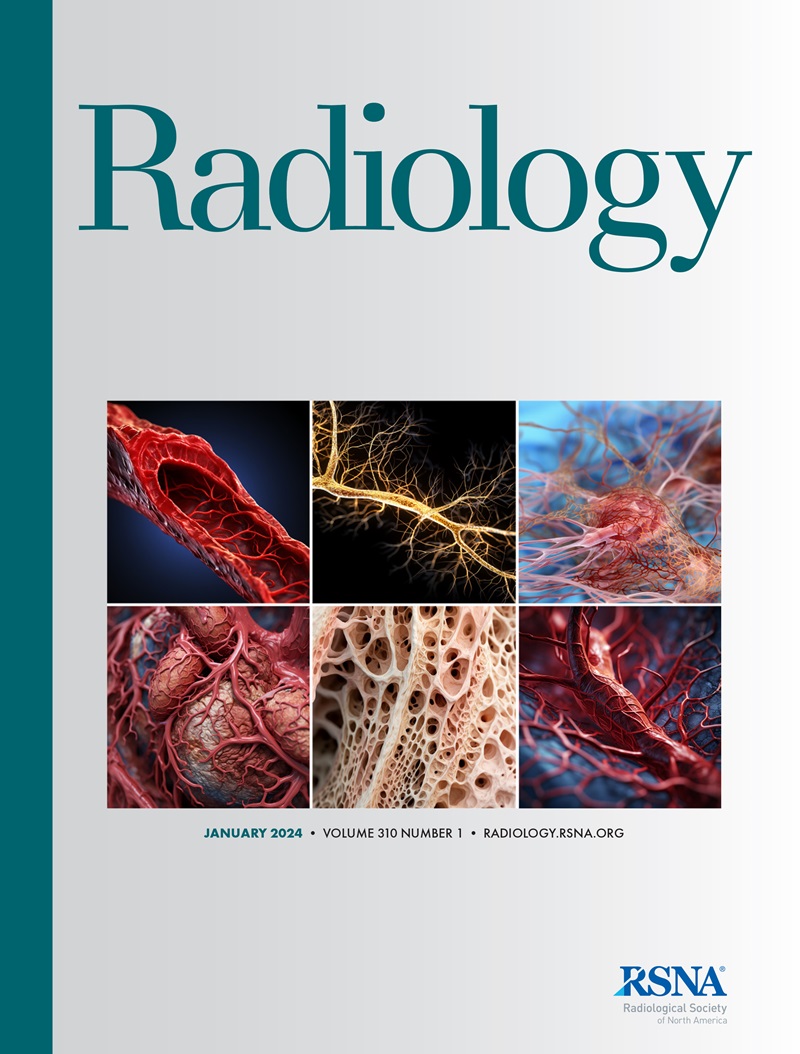Comparing Multi-b- Value Diffusion MRI Models for Predicting Pathologic Complete Response to Neoadjuvant Chemotherapy in Breast Cancer.
IF 12.1
1区 医学
Q1 RADIOLOGY, NUCLEAR MEDICINE & MEDICAL IMAGING
Xueqin Gong, Xiaoxia Wang, Lu Wang, Xiangfei Zeng, Sun Tang, Yue Cheng, Tao Yu, Yao Huang, Ying Cao, Huifang Chen, Fujie Jiang, Shuling Liu, Lan Li, Ting Yin, Jiuquan Zhang
求助PDF
{"title":"Comparing Multi-<i>b-</i>Value Diffusion MRI Models for Predicting Pathologic Complete Response to Neoadjuvant Chemotherapy in Breast Cancer.","authors":"Xueqin Gong, Xiaoxia Wang, Lu Wang, Xiangfei Zeng, Sun Tang, Yue Cheng, Tao Yu, Yao Huang, Ying Cao, Huifang Chen, Fujie Jiang, Shuling Liu, Lan Li, Ting Yin, Jiuquan Zhang","doi":"10.1148/radiol.242969","DOIUrl":null,"url":null,"abstract":"<p><p>Background Multi-<i>b-</i>value diffusion MRI models have been used to predict pathologic complete response (pCR) to neoadjuvant chemotherapy (NAC) for breast cancer. However, there is a lack of longitudinal comparative research. Purpose To compare the performance of various diffusion MRI-derived longitudinal parameters during NAC for prediction of pCR in breast cancer. Materials and Methods This prospective study included consecutive women with breast cancer enrolled between February 2021 and June 2023 and treated with six or eight cycles of NAC. Each woman underwent intravoxel incoherent motion (IVIM) imaging and diffusion kurtosis imaging (DKI) before NAC (time point <i>T</i><sub>1</sub>) and after two, four, and six cycles of NAC (<i>T</i><sub>2</sub>, <i>T</i><sub>3</sub>, and <i>T</i><sub>4</sub>, respectively). The apparent diffusion coefficient (ADC) and IVIM and DKI parameters were compared using repeated-measures analysis of variance. Backward stepwise multivariable logistic regression analysis was used to identify parameters associated with pCR. Model performance was assessed using the area under the receiver operating characteristic curve (AUC) and was compared using the DeLong test. Results Among 160 women (mean age, 49.73 years ± 8.39 [SD]), 36 had pCR. ADC, tissue diffusion coefficient, and non-Gaussian ADC (<i>D</i><sub>app</sub>) demonstrated significant differences between the pCR group and non-pCR group (<i>P</i> = .04, .02, and .01, respectively). At <i>T</i><sub>2</sub>, progesterone receptor positivity (odds ratio [OR], 0.10 [95% CI: 0.02, 0.48]; <i>P</i> = .004) was associated with lower odds of pCR, while human epidermal growth factor receptor 2 positivity (OR, 4.51 [95% CI: 1.64, 12.45]; <i>P</i> = .004), higher <i>D</i><sub>app</sub> (OR, 8.44 [95% CI: 3.28, 21.72]; <i>P</i> < .001), and higher apparent kurtosis coefficient (OR, 7.69 [95% CI: 3.03, 19.53]; <i>P</i> < .001) were associated with higher odds of pCR. The clinicopathologic-DKI model integrating these parameters exhibited an AUC of 0.90 (95% CI: 0.84, 0.94) in predicting pCR, outperforming the clinicopathologic model (AUC, 0.79 [95% CI: 0.72, 0.85]; <i>P</i> < .001) and clinicopathologic-IVIM model (AUC, 0.84 [95% CI: 0.77, 0.89]; <i>P</i> = .04). Conclusion A model combining clinicopathologic variables and DKI parameters after early NAC showed excellent performance in predicting pCR to NAC for breast cancer. © RSNA, 2025 <i>Supplemental material is available for this article.</i> See also the editorial by Thakur and Bitencourt in this issue.</p>","PeriodicalId":20896,"journal":{"name":"Radiology","volume":"316 1","pages":"e242969"},"PeriodicalIF":12.1000,"publicationDate":"2025-07-01","publicationTypes":"Journal Article","fieldsOfStudy":null,"isOpenAccess":false,"openAccessPdf":"","citationCount":"0","resultStr":null,"platform":"Semanticscholar","paperid":null,"PeriodicalName":"Radiology","FirstCategoryId":"3","ListUrlMain":"https://doi.org/10.1148/radiol.242969","RegionNum":1,"RegionCategory":"医学","ArticlePicture":[],"TitleCN":null,"AbstractTextCN":null,"PMCID":null,"EPubDate":"","PubModel":"","JCR":"Q1","JCRName":"RADIOLOGY, NUCLEAR MEDICINE & MEDICAL IMAGING","Score":null,"Total":0}
引用次数: 0
引用
批量引用
Abstract
Background Multi-b- value diffusion MRI models have been used to predict pathologic complete response (pCR) to neoadjuvant chemotherapy (NAC) for breast cancer. However, there is a lack of longitudinal comparative research. Purpose To compare the performance of various diffusion MRI-derived longitudinal parameters during NAC for prediction of pCR in breast cancer. Materials and Methods This prospective study included consecutive women with breast cancer enrolled between February 2021 and June 2023 and treated with six or eight cycles of NAC. Each woman underwent intravoxel incoherent motion (IVIM) imaging and diffusion kurtosis imaging (DKI) before NAC (time point T 1 ) and after two, four, and six cycles of NAC (T 2 , T 3 , and T 4 , respectively). The apparent diffusion coefficient (ADC) and IVIM and DKI parameters were compared using repeated-measures analysis of variance. Backward stepwise multivariable logistic regression analysis was used to identify parameters associated with pCR. Model performance was assessed using the area under the receiver operating characteristic curve (AUC) and was compared using the DeLong test. Results Among 160 women (mean age, 49.73 years ± 8.39 [SD]), 36 had pCR. ADC, tissue diffusion coefficient, and non-Gaussian ADC (D app ) demonstrated significant differences between the pCR group and non-pCR group (P = .04, .02, and .01, respectively). At T 2 , progesterone receptor positivity (odds ratio [OR], 0.10 [95% CI: 0.02, 0.48]; P = .004) was associated with lower odds of pCR, while human epidermal growth factor receptor 2 positivity (OR, 4.51 [95% CI: 1.64, 12.45]; P = .004), higher D app (OR, 8.44 [95% CI: 3.28, 21.72]; P < .001), and higher apparent kurtosis coefficient (OR, 7.69 [95% CI: 3.03, 19.53]; P < .001) were associated with higher odds of pCR. The clinicopathologic-DKI model integrating these parameters exhibited an AUC of 0.90 (95% CI: 0.84, 0.94) in predicting pCR, outperforming the clinicopathologic model (AUC, 0.79 [95% CI: 0.72, 0.85]; P < .001) and clinicopathologic-IVIM model (AUC, 0.84 [95% CI: 0.77, 0.89]; P = .04). Conclusion A model combining clinicopathologic variables and DKI parameters after early NAC showed excellent performance in predicting pCR to NAC for breast cancer. © RSNA, 2025 Supplemental material is available for this article. See also the editorial by Thakur and Bitencourt in this issue.
比较多b值扩散MRI模型预测乳腺癌新辅助化疗病理完全缓解。
多b值扩散MRI模型已被用于预测乳腺癌新辅助化疗(NAC)的病理完全缓解(pCR)。然而,目前还缺乏纵向比较研究。目的比较NAC期间各种扩散mri纵向参数对乳腺癌pCR的预测效果。材料和方法本前瞻性研究纳入了2021年2月至2023年6月期间连续入组的乳腺癌女性,接受6或8个周期的NAC治疗。每位妇女在NAC前(时间点T1)和NAC后2、4、6个周期(分别为T2、T3和T4)分别进行体素内非相干运动(IVIM)成像和扩散峰态成像(DKI)。采用重复测量方差分析比较表观扩散系数(ADC)、IVIM和DKI参数。采用后向逐步多变量logistic回归分析确定与pCR相关的参数。使用受试者工作特征曲线下面积(AUC)评估模型性能,并使用DeLong检验进行比较。结果160例女性(平均年龄49.73岁±8.39 [SD])中,36例有pCR。pCR组与非pCR组ADC、组织扩散系数、非高斯ADC (Dapp)差异有统计学意义(P值分别为0.04、0.02、0.01)。T2时,孕酮受体阳性(优势比[OR], 0.10 [95% CI: 0.02, 0.48];P = 0.004)与较低的pCR几率相关,而人表皮生长因子受体2阳性(OR, 4.51 [95% CI: 1.64, 12.45];P = 0.004),较高的Dapp (OR, 8.44 [95% CI: 3.28, 21.72];P < 0.001),且较高的表观峰度系数(OR, 7.69 [95% CI: 3.03, 19.53];P < 0.001)与pCR的高几率相关。整合这些参数的临床病理- dki模型预测pCR的AUC为0.90 (95% CI: 0.84, 0.94),优于临床病理模型(AUC为0.79 [95% CI: 0.72, 0.85];P < 0.001)和临床病理- ivim模型(AUC, 0.84 [95% CI: 0.77, 0.89];P = .04)。结论结合早期NAC后的临床病理变量和DKI参数建立的模型对预测pCR对NAC的诊断有较好的效果。©RSNA, 2025本文可获得补充材料。另见Thakur和bitcourt在本期的社论。
本文章由计算机程序翻译,如有差异,请以英文原文为准。

 求助内容:
求助内容: 应助结果提醒方式:
应助结果提醒方式:


